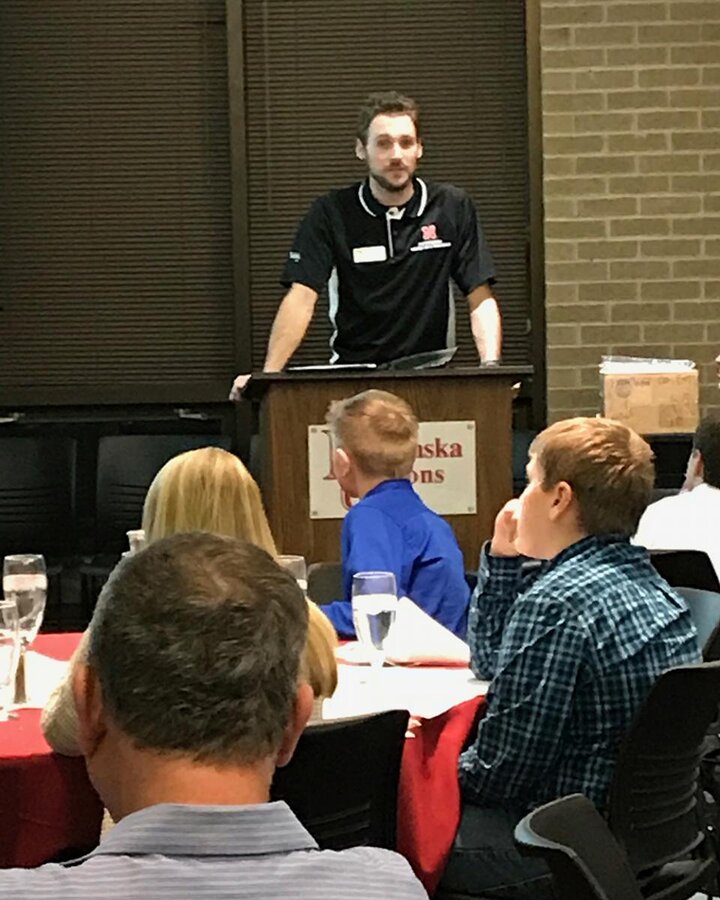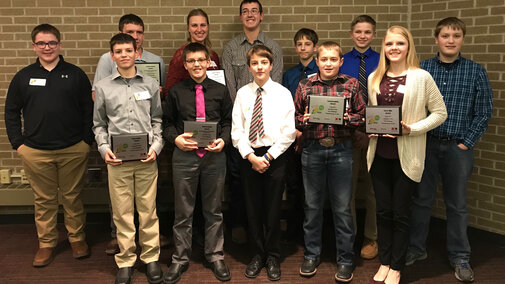The Rising Stars 4-H Club from Platte County were just what their name suggested, winning the Innovative Youth Corn Challenge (IYCC) for 2017. Last week they and other winners were recognized at the annual awards banquet for their work to develop and conduct field trials to test innovative corn production practices.

2018 Entries Due March 15
To participate in the 2018 Innovative Youth Corn Challenge, youth must complete and return an entry form by March 15 to the Fillmore County Extension Office in Geneva. Forms can be downloaded at http://cropwatch.unl.edu/youth/cornchallenge.
For more information, contact VanDeWalle at brandy.vandewalle@unl.edu.
The Innovative Youth Corn Challenge was created in 2012 to engage youth in crop science-based education through boots-on-the-ground research and learning, said program coordinator and Nebraska Extension Educator Brandy VanDeWalle.
"Science, technology, engineering, and math (STEM) careers are in high demand and will continue to be in future years," VanDeWalle said. "To engage youth in crop science-based education, the Innovative Youth Corn Challenge was created as a partnership between the Nebraska Corn Board and Nebraska Extension."
Since its inception, 35 teams have participated with 20 teams successfully harvesting and analyzing their plot data. A total of 105 youth have participated. The contest, open to 4-H or FFA members, guides participants through all aspects of corn production, as well as providing information on agricultural careers related to corn production.
Throughout the competition, youth teams work with adult mentors, who can be extension faculty, ag teachers, or other qualified agronomy professionals.
The Rising Stars 4-H Club from Platte County consisted of Kade and Isaac Stromberg; Brad Stephens was their sponsor. The team tested a mid-season V6 application of ammonium sulfate on corn yield, a treatment which cost $18 per acre. Their hypothesis was that ammonium sulfate would increase yield by making more nitrogen available before tasseling. Their check plot had a yield of 265.6 bushels/acre compared to the innovative plot yield of 270.4 bushels/acre. For finishing first in the competition, they received $1,000.
Placing second overall was the Wood River FFA team of Nathan Burnett and Zane Turek with Juliana Loudon as their sponsor. They tested the potential for a yield increase from using a higher planting population for dryland corn than is normally used in their area. They compared the standard practice of planting a population of 21,000 seeds per acre with planting 26,000 seeds per acre. The team faced an added "real-world" challenge this year with an influx of Palmer amaranth in their test plot. In the end, their check plot produced 220 bushels/acre while the challenge plot produced 192 bushels/acre. For finishing second in the competition, they received $500.
Third place went to the Lost Creek 4-H Club from Colfax County (see story, Keeping it in the Family - How One Team Competed in the IYCC). It consisted of Logan, Gavin, and Rylan Nelson with Steve Nelson as their sponsor. They tested the use of automatic down pressure management versus four static down pressure levels on yield. Their plot had five treatments: automatic down pressure and 0, 125, 250, and 375 lbs of downforce. Yields were 195, 193, 197, 201, and 198 bushels per acre, respectively. For finishing third in the competition, they received $250.
Also, completing their plot research were:
The Maple Creek Creators 4-H Club of Colfax County, consisting of Korbin and Kara Kudera; sponsor was Kevin Kudera. They tested the use of an in-furrow 8-20-5-5-.05 starter fertilizer as they switched from minimum to no-till. They observed that dry weather and a high salt fertilizer may have affected their challenge plot. Their ending yield was 173.1 bushels/acre for the control and 170.3 bushels/acre for their starter fertilizer plot.
The Kornhusker Kids 4-H Club of Cuming County which included Kaleb and Landon Hasenkamp, Angela, Matthew and James Rolf, Levi Schiller and Payton Schiller used a plot in Dodge County to test their theory. They looked at the effects of interseeding two different cover crops into standing corn at V5. Their goal was to increase nutrient availability to the crop while allowing for the earlier establishment of the cover crop. The plot included a control with no cover crop as well as medium red clover and tillage radishes. Unfortunately, Nebraska’s weather got the better of them with a dry June resulting in poor cover crop establishment.
Clover Catchers 4-H Club of Otoe County tested yield differences between corn hybrids with different insect traits. The team consisted of Hayden and Nolan Beccard; Ryan Beccard was the sponsor. Their study looked at whether planting corn with a rootworm trait would increase yield by controlling rootworm with extended diapause in a corn/soybean rotation. The plot with no rootworm trait had a yield of 176.6 bushels/acre compared to the innovative test plot which had a yield of 175.9 bushels/acre.
The Shelton FFA Chapter consisted of Jacob Snyder and Ryan Lewis with Hannah Horak as their sponsor. They tested the addition of Agnition products on corn yield. Their check plot had a yield of 230 bushels/acre compared to the innovative plot yield of 228.5 bushels/acre.
Other awards included:
- The Extra Mile Award and $200 went to Kornhusker Kids 4-H Club.
- The Innovation Award and $200 went to the Lost Creek 4-H’ers.
- The Sustainability Award and $200 went to the Kornhusker Kids 4-H Club, whose trial was conducted in dryland conditions. Their project used the Field to Market tool, a leading multi-stakeholder initiative working to unite the agricultural supply chain in defining, measuring and advancing the sustainability of food, fiber and fuel production in the United States.

